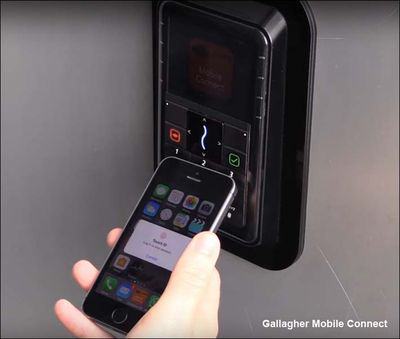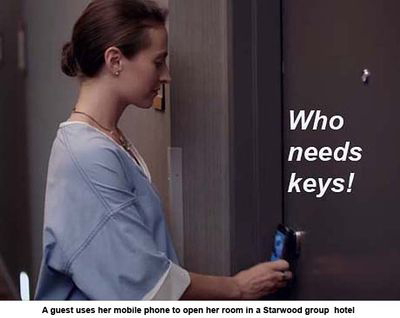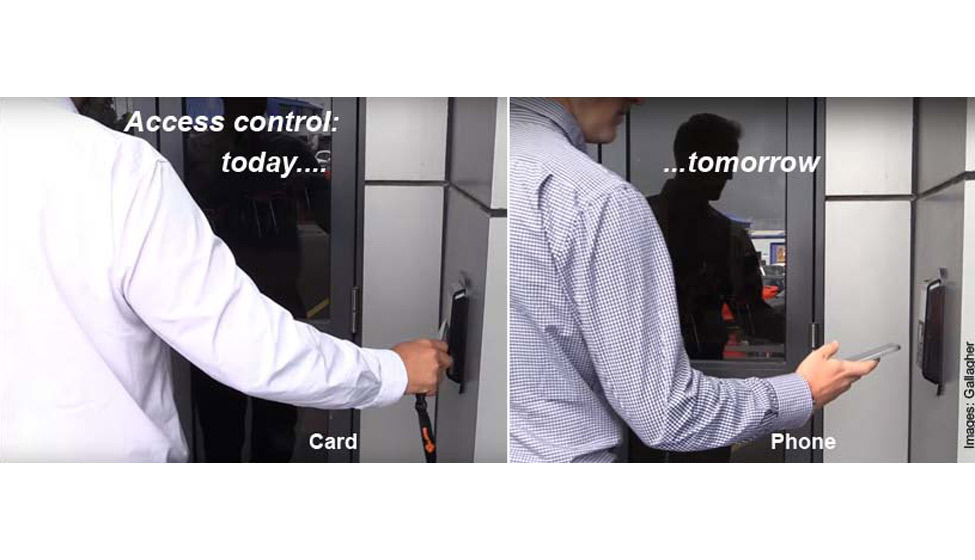Swiping a smart ID card to enter restricted spaces in your office? That may soon be passe!
By 2020, employees in one in five corporations will use smartphones in place of traditional physical access cards, to finds a January 2017 Gartner study. Last year less than 5 percent of organizations used smartphones to enable access to offices and other premises.|
Says Gartner Research Director David Anthony Mahdi: "A significant fraction of organizations use legacy physical access technologies that are proprietary, closed systems and have limited ability to integrate with IT infrastructure. Today, the increasing availability of mobile and cloud technologies from many physical access control system (PACS) vendors will have major impacts on how these systems can be implemented and managed."
PACS technology is widely deployed across multiple vertical industries and geographies to secure access to a wide range of facilities (buildings, individual offices, data centers, plant rooms, warehouses and so on), ensuring that only entitled people (employees, contractors, visitors, maintenance staff) get access to specific location.
Mobile technology is already widely used for logical access control. Phone-as-a-token authentication methods continue to be the preferred choice in the majority of new and refreshed token deployments as an alternative to traditional one-time password (OTP) hardware tokens. Gartner projects that the same kinds of cost and user experience (UX) benefits will drive increasing use of smartphones in place of discrete physical access cards. Smartphones using technologies and protocols such as Bluetooth, Bluetooth LE, and Near Field Communication can work with a number of readers and PACS technology.
One of the easiest ways to use a smartphone's access credentials is to integrate them — via a data channel over the air or via Wi-Fi — into the access control system (ACS) and "unlock the door" remotely (just as an ACS administrator can). This approach requires no change to reader hardware.
Using smartphones can also simplify the integration of biometric technologies. "Rather than having to add biometric capture devices in or alongside readers, the phone itself can easily be used as a capture device for face or voice (or both), with comparison and matching done locally on the phone or centrally," adds Mahdi. "This approach also mitigates the risks from an attacker who gains possession of a person's phone."
The technology's limitations remain a challenge. For example, there's significant disparity in functionality between smartphones, and physical card readers and PACS might require a significant upgrade to use smartphones for physical access.
Mobile Connect? already available!

Mobile phone access is already here: In December 2016, leading New Zealand based technology manufacturer, Gallagher, announced the global release of its latest state-of-the-art mobile security solution: Gallagher Mobile Connect. Harnessing Bluetooth wireless technology and the power of smart phones, Mobile Connect transforms a mobile phone in to an access device – empowering businesses to use mobile technology in place of traditional access cards. Using two-step remote provisioning, Mobile Connect delivers secure enrolment by sending an email invitation with SMS code to verify the user and mobile device. This creates further administration efficiencies by removing the need to physically deliver an access card. Optional two-factor authentication, either PIN or biometric, provides added security and flexibility for sites using Mobile Connect.
The Gallagher Mobile Connect App allows you to use your mobile device just like an access card. Mobile Connect is freely downloadable from the Apple App and Google Play stores.
Keyless hotel room entry has come to India

You don't need a key or a key card to enter your room if you are a guest in the Starwood group's Aloft Hotel within the Cessna Business Park in Bangalore: You can use your mobile phone.
Starwood Preferred Guest the group's loyalty programme introduced the hospitality industry’s first mobile, keyless entry system in this country, just three months after its global launch in US properties in 2015
Said Dilip Puri, Managing Director India and Regional Vice President South Asia:“We are delighted to be the first Hotel company to launch Keyless Check-in in India. Aloft Bengaluru Cessna Business Park was the natural choice given the Aloft brand’s strong focus on forward-design and tech-savvy spaces and the fact that this hotel is located within the city’s hot high tech hub."
Starwood has been rapidly rolling out SPG Keyless with plans for it to be available on 30,000 doors in 150 hotels across Aloft, Element and W hotels. SPG Keyless is available to SPG members who book a hotel room through one of Starwood’s channels (hotel websites, SPG.com, the SPG app or customer contact centers).
HOW IT WORKS
SPG Members must register their phone once through the SPG App and allow push notifications.
After booking a reservation at a keyless hotel and approximately 24 hours before arrival, SPG members are invited to opt-in to SPG Keyless.
Guests will receive a push notification noting that they are checked in and the SPG App will update with his/her room number and Bluetooth key when the room is ready.
Upon arrival at the hotel, the guest can completely bypass the front desk (where available) and go directly to his/her room.
After ensuring his/her Bluetooth is enabled, the guest simply opens the SPG App, holds the smart phone to the door lock, waits for the solid green light and enters the room.





